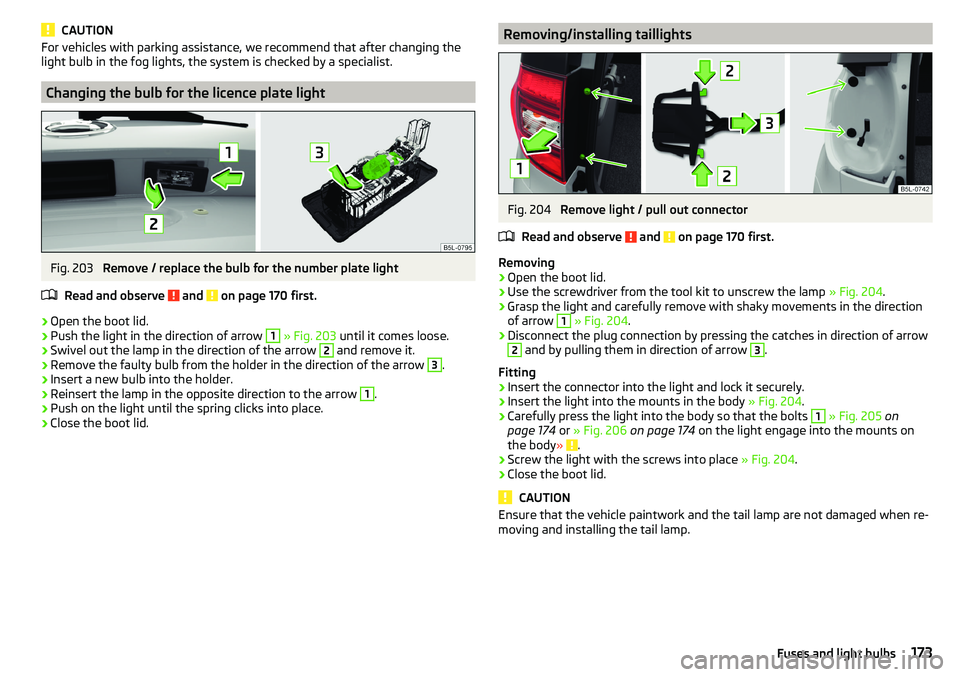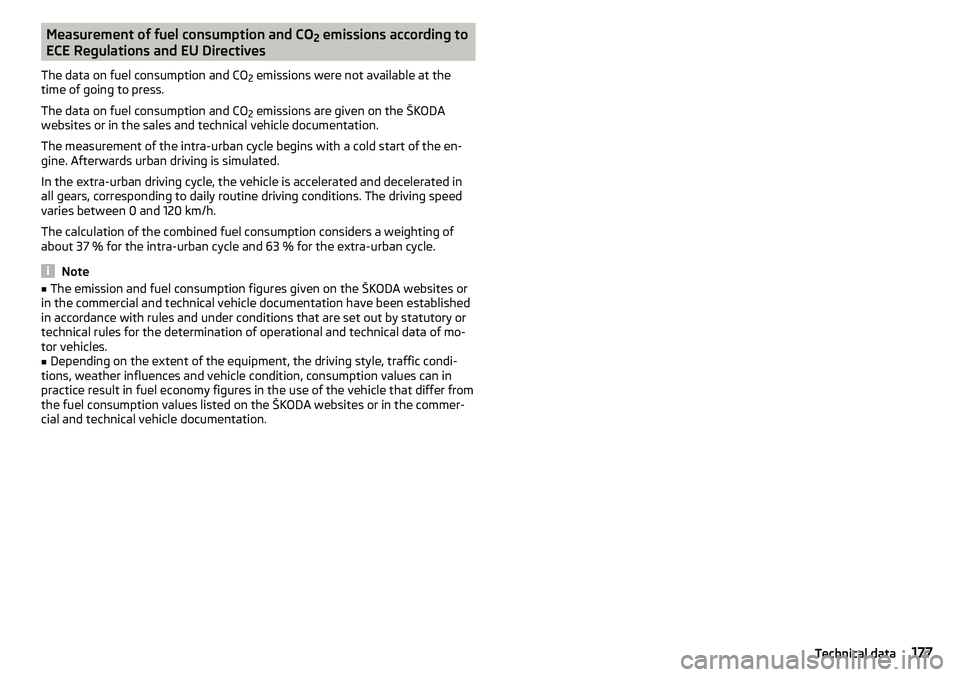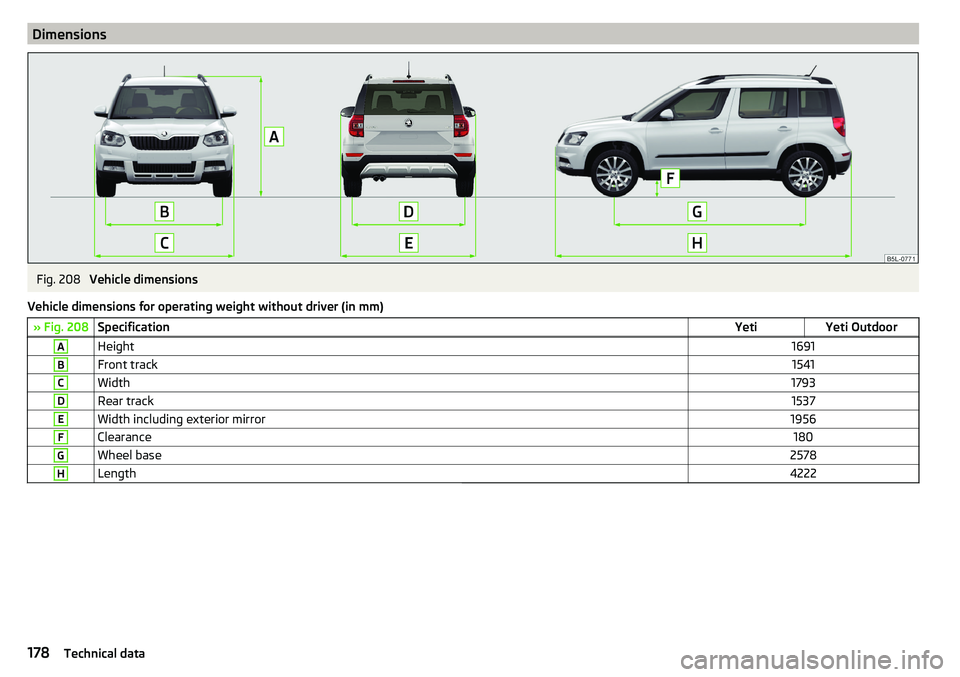SKODA YETI 2017 Owner´s Manual
Manufacturer: SKODA, Model Year: 2017, Model line: YETI, Model: SKODA YETI 2017Pages: 200, PDF Size: 28.93 MB
Page 171 of 200

No.Consumer27Panoramic tilt / slide sunroof, electric operation of sun blinds28Fuel pump, injectors, AdBlue®
heating29Electric windows - front, outside mirror - Heating, fold-in function,
Adjusting the mirror surface3012 volt power outlet - front and rear31Headlight cleaning system32Heated front seats33Heating, air conditioning, Climatronic, remote control for auxiliary
heating34Car alarm, reserve horn35Automatic gearbox36Tow hitch
Fuses in the engine compartment
Fig. 195
Distribution board cover.
Read and observe and on page 167 first.
With some equipment, the battery cover must be opened before removing the
cover for the fuse box » page 148.
Replacing fuses
›
Turn the securing bracket
A
» Fig. 195 in direction of the arrow. The symbol
is displayed behind the catches. .
›
Remove the cover.
›
Replace the appropriate fuse.
›
Replace the cover on the fuse box and the safety clip
A
move against the
arrow. The symbol is displayed behind the catches .
CAUTIONThe cover of the fuse box in the engine compartment must always be used
correctly, otherwise water may penetrate into the fuse box – there is a risk of
damage to the vehicle!
Fuse arrangement in the engine compartment
Fig. 196
Fuses
Read and observe and on page 167 first.
No.Consumer1Not assigned2Automatic gearbox, AdBlue control system3Battery data module4ABS5Automatic gearbox6Not assigned7Power supply for terminal 15, starter8Radio, instrument cluster, telephone9Not assigned10Engine control system11Aux. heating and ventilation12Databus13Engine control system14Ignition15Lambda probe, fuel pump, glow plug system16Right headlight, right taillight17Horn 169Fuses and light bulbs
Page 172 of 200

No.Consumer18Music amplifier19Windscreen wipers20Control valve for fuel pressure, high pressure pump21Lambda probe22Clutch pedal switch, brake pedal switch23Coolant pump, loading pressure control valve, switchover valve for
radiator, fuel pump24Active charcoal filter, exhaust gas recirculation valve, radiator fan25ABS26Left front headlight, left taillight27Glow plug system28Windscreen heater29Power to the internal fuse carrier (fuses no. 24,27,31,32), electrically
adjustable seats30Terminal X a)a)
In order not to drain the battery unnecessarily when starting the engine, the electrical components of
this terminal are automatically switched off.
Bulbs
Introduction
This chapter contains information on the following subjects:
Bulb arrangement in the front headlights
171
Changing bulbs for low and main beam (Halogen headlights)
171
Remove protective guard for foglights
171
Protective grille for removing fog lights- plug for Park Assist sensor
172
Changing light bulbs for fog lights
172
Changing the bulb for the licence plate light
173
Removing/installing taillights
173
Replacing the bulbs in the taillight assembly
174
We recommend having bulbs replaced by a specialist garage or seeking other
expert help in the event of any uncertainties.
▶ Switch off the ignition and all of the lights before replacing a bulb.
▶ Faulty bulbs must only be replaced with the same type of bulbs. The designa-
tion is located on the light socket or the glass bulb.
We recommend having the headlight settings checked by a specialist garage after replacing a bulb in the low, high or fog beam.
In the case of failure of a Xenon gas discharge bulb or an LED diode, visit a
specialist garage.WARNING■ Always read and observe the warnings before completing any work in the
engine compartment » page 142.■
Accidents can be caused if the road in front of the vehicle is not suffi-
ciently illuminated and the vehicle cannot or can only be seen with difficul-
ty by other road users.
■
Bulbs H7 and H4 are pressurised and may burst when changed - there is a
risk of injury. We therefore recommended wearing gloves and safety
glasses when changing a bulb.
■
Do not carry out any work on the Xenon gas discharge lamps - risk of
death!
CAUTION
Do not take hold of the glass bulb with naked fingers (even the smallest
amount of dirt reduces the working life of the light bulb). Use a clean cloth,
napkin, or similar.
Note
■ This Owner's Manual only describes the replacement of bulbs where it is pos-
sible to replace the bulbs on your own without any complications arising. Other
bulbs must be replaced by a specialist garage.■
We recommend that a box of replacement bulbs always be carried in the ve-
hicle.
170Do-it-yourself
Page 173 of 200

Bulb arrangement in the front headlightsFig. 197
Left headlight
Read and observe and on page 170 first.
Bulb arrangement » Fig. 197
Low beam with halogen bulb or Xenon gas discharge bulb
Main beam
Changing bulbs for low and main beam (Halogen headlights)
Fig. 198
Replacing the bulb for low beam and main beam
Read and observe
and on page 170 first.
›
Turn the respective protective cap » Fig. 197 on page 171 counter-clockwise
and remove.
When removing the cap, make sure that this does not fall into the engine com-
partment.
›
Disconnect the relevant connector with the light bulb in the direction of ar-
row
1
» Fig. 198 .
AB›Remove the connector to the bulb in the direction of arrow 2.›Remove the connector.›
Insert the connector with the new bulb so that the fixing lug
A
fits on the
bulb » Fig. 198 into the recess on the reflector.
›
Insert the respective protective cap » Fig. 197 on page 171 and rotate it clock-
wise until it stops.
Note
We recommend you have the bulb replacement performed by a specialist ga-
rage.
Remove protective guard for foglights
Fig. 199
Guard: Version 1/version 2
Read and observe
and on page 170 first.
›
Undo the protective grille in the direction of the arrow » Fig. 199 using the
clamp for removing the wheel trims.
›
Remove the protective grille.
171Fuses and light bulbs
Page 174 of 200

Protective grille for removing fog lights- plug for Park AssistsensorFig. 200
Guard: Version 1/version 2
Fig. 201
Remove the plug
Read and observe
and on page 170 first.
›
Remove the plastic cover for the guard in the arrow direction » Fig. 200 using
the bow to pull the full wheel covers.
›
Remove the remaining part of the grille.
›
Pull the latch out of the connector in the direction of arrow
1
» Fig. 201 .
›
Undo the latch on the connector in the direction of arrow
2
.
›
Remove the key in the direction of the arrow
3
.
Insertion of the ashtray takes place in reverse order.
Changing light bulbs for fog lightsFig. 202
Remove the number plate light / replace the bulb
Read and observe
and on page 170 first.
First remove the grille for the fog lights and before changing bulbs » Fig. 199
on page 171 and / or » Fig. 200 on page 172 .
Removing the headlight
›
Unscrew the screws
A
» Fig. 202 with the screwdriver from the tool kit.
›
Remove the headlight in the direction of arrow
1
.
›
Remove the headlight in the direction of arrow
2
.
Replacing the light bulb
›
Pull the plug on the lamp base.
›
Turn the socket with the bulb to the stop in the direction of the arrow
3
» Fig. 202 .
›
Insert the new bulb into the headlight and turn counter to the direction of
arrow
3
as far as the stop.
›
Attach the connector on the lamp base.
Refit the headlight and grille
›
Replace the fog light by inserting it in the opposite direction of the arrow
2
» Fig. 202 and tighten.
›
Attach the connector on guard carefully » Fig. 201 on page 172 1)
.
›
Insert the protective grille and press it in.
›
Replace the plastic cover and press into the guard » Fig. 200 on page 172 1 )
.
The protective grille must engage firmly.
1)
Applies to vehicles with parking assistance system.
172Do-it-yourself
Page 175 of 200

CAUTIONFor vehicles with parking assistance, we recommend that after changing the
light bulb in the fog lights, the system is checked by a specialist.
Changing the bulb for the licence plate light
Fig. 203
Remove / replace the bulb for the number plate light
Read and observe
and on page 170 first.
›
Open the boot lid.
›
Push the light in the direction of arrow
1
» Fig. 203 until it comes loose.
›
Swivel out the lamp in the direction of the arrow
2
and remove it.
›
Remove the faulty bulb from the holder in the direction of the arrow
3
.
›
Insert a new bulb into the holder.
›
Reinsert the lamp in the opposite direction to the arrow
1
.
›
Push on the light until the spring clicks into place.
›
Close the boot lid.
Removing/installing taillightsFig. 204
Remove light / pull out connector
Read and observe
and on page 170 first.
Removing
›
Open the boot lid.
›
Use the screwdriver from the tool kit to unscrew the lamp » Fig. 204.
›
Grasp the light and carefully remove with shaky movements in the direction
of arrow
1
» Fig. 204 .
›
Disconnect the plug connection by pressing the catches in direction of arrow
2
and by pulling them in direction of arrow
3
.
Fitting
›
Insert the connector into the light and lock it securely.
›
Insert the light into the mounts in the body » Fig. 204.
›
Carefully press the light into the body so that the bolts
1
» Fig. 205 on
page 174 or » Fig. 206 on page 174 on the light engage into the mounts on
the body »
.
›
Screw the light with the screws into place » Fig. 204.
›
Close the boot lid.
CAUTION
Ensure that the vehicle paintwork and the tail lamp are not damaged when re-
moving and installing the tail lamp.173Fuses and light bulbs
Page 176 of 200

Replacing the bulbs in the taillight assemblyFig. 205
Inner part of the light: Ground light
Fig. 206
Inner part of the light: Light with LED diodes
Read and observe
and on page 170 first.
Ground light
›
With the spanner from the vehicle tools unscrew the securing screw
A
» Fig. 205 .
›
Unlock the bulb holder using the locking latches in the areas » Fig. 205
marked with arrows and remove the bulb holder from the light.
›
Turn the respective bulb
B
until it stops counter-clockwise and remove it
from the bulb holder.
›
Insert a new bulb
B
into the holder and turn in a clockwise direction to the
stop.
›
Pull bulb
C
out of the socket and insert a new bulb.
›
Insert the lamp holder in the lamp and screw in the locking screw
A
» Fig. 205 .
Light with LED diodes›Unlock the bulb holder using the locking latches in the areas » Fig. 206
marked with arrows and remove the bulb holder from the light.›
Turn the respective light bulb » Fig. 206 until it stops counter-clockwise and
remove it from the bulb holder.
›
Insert a new bulb into the holder and turn in a clockwise direction to the
stop.
›
Insert the lamp holder in the lamp until it is secure.
174Do-it-yourself
Page 177 of 200

Technical data
Technical data
Basic vehicle data
Introduction
This chapter contains information on the following subjects:
Vehicle data
175
Operating weight
176
Payload
176
Measurement of fuel consumption and CO 2 emissions according to ECE
Regulations and EU Directives
177
Dimensions
178
Angle and gradeability
179
The details given in the vehicle's technical documentation always take prece-
dence over the details in the Owner's Manual.
The performance values listed were determined without performance-reduc- ing equipment, e.g. air conditioning system.
The values given have been determined in accordance with regulations and in
conditions prescribed by legal or technical provisions for determining the oper-
ating and technical data of vehicles.
The values listed are for the basic model without optional equipment.
Vehicle dataFig. 207
Vehicle data sticker/type plate
Vehicle data sticker
The vehicle data sticker » Fig. 207 -
is located on the base of the luggage
compartment and is also stuck into the Owner's Manual.
The vehicle data sticker contains the following data. Vehicle identification number (VIN)
Vehicle type
Gearbox code/paint number/interior equipment/engine output/engine code
Partial vehicle description
Approved tyre diameter in inches 1)
The approved tyres and rim sizes for your vehicle are listed in the vehicle's
technical documentation (the so called COC document) and this also states the
declaration of conformity.
Type plate
The type plate » Fig. 207 -
is located at the bottom of the B-pillar on the
right driver's side.
The type plate contains the following data. Vehicle manufacturers
Vehicle identification number (VIN)
Maximum permissible gross weight
Maximum permissible towed weight (towing vehicle and trailer)
1234567891)
Only valid for some countries.
175Technical data
Page 178 of 200

Maximum permissible front axle load
Maximum permissible rear axle load
Vehicle identification number (VIN)
The vehicle identification number - VIN (vehicle body number) is stamped into
the engine compartment on the right hand suspension strut dome. This num-
ber is also located on a sign on the lower left hand edge below the windscreen
(together with a VIN bar code), and on the type plate.
Engine number
The engine number (three-digit identifier and serial number) is stamped on the
engine block.
Supplementary Information (applies to Russia)
The full type approval number of the means of transport is indicated in the
registration documents, field 17.
Maximum permissible trailer weight
The listed maximum permissible trailer weight is only valid for altitudes up to 1000 m above sea level.
The engine output falls as altitude increases, as does the vehicle's climbing
power. Therefore, for every additional 1000 m in height (or part), the maximum
permissible towed weight must be reduced by 10%.
The towed weight is made up of the actual weights of the loaded towing vehi-
cle and the loaded trailer.WARNINGDo not exceed the specified maximum permissible weights – risk of acci-
dent and damage!
Operating weight
This value is only a guide value and corresponds to the lowest possible operat-
ing weight without further weight-reducing equipment (e.g. air conditioning,
spare wheel etc.). It also includes a weight allowance for the driver (75 kg), the
weight of the operating fluids, the tool kit and a fuel tank filled to 90 % ca-
pacity.
1011Operating weightEngineTransmissionOperating weight (kg)1.2 ltr./81 kW TSIMG1340DSG13601.4 ltr./92 kW TSIMG1355DSG13801.4 ltr./110 kW TSIMG 4x41471DSG 4x414961.6 l./81 kW MPIMG1320AG13451.8 ltr./112 kW TSIDSG 4x41540
2.0 ltr./81 kW TDI CR
MG (EU4)1420MG (EU6)1452MG 4x415502.0 ltr./103 kW TDI CRMG 4x41535DSG 4x41560
2.0 ltr./110 kW TDI CR
MG1486MG 4x41565DSG 4x41585
Note
If required, you can find out the precise weight of your vehicle at a specialist
garage.
Payload
It is possible to calculate the approximate maximum payload from the differ-
ence between the permissible total weight and the operating weight.
The payload consists of the following weights.
▶ The weight of the passengers.
▶ The weight of all items of luggage and other loads.
▶ The weight of the roof, including the roof rack system.
▶ The weight of the equipment that is excluded from the operating weight.
▶ The trailer drawbar load when towing a trailer (max. 80 kg or 85 kg for vehi-
cles 4x4 with the 2.0 l / 103 kW TDI CR and 2.0 l / 110 kW TDI CR engine).
176Technical data
Page 179 of 200

Measurement of fuel consumption and CO2 emissions according to
ECE Regulations and EU Directives
The data on fuel consumption and CO 2 emissions were not available at the
time of going to press.
The data on fuel consumption and CO 2 emissions are given on the ŠKODA
websites or in the sales and technical vehicle documentation.
The measurement of the intra-urban cycle begins with a cold start of the en-
gine. Afterwards urban driving is simulated.
In the extra-urban driving cycle, the vehicle is accelerated and decelerated in
all gears, corresponding to daily routine driving conditions. The driving speed
varies between 0 and 120 km/h.
The calculation of the combined fuel consumption considers a weighting of
about 37 % for the intra-urban cycle and 63 % for the extra-urban cycle.
Note
■ The emission and fuel consumption figures given on the ŠKODA websites or
in the commercial and technical vehicle documentation have been established
in accordance with rules and under conditions that are set out by statutory or
technical rules for the determination of operational and technical data of mo-
tor vehicles.■
Depending on the extent of the equipment, the driving style, traffic condi-
tions, weather influences and vehicle condition, consumption values can in
practice result in fuel economy figures in the use of the vehicle that differ from
the fuel consumption values listed on the ŠKODA websites or in the commer-
cial and technical vehicle documentation.
177Technical data
Page 180 of 200

DimensionsFig. 208
Vehicle dimensions
Vehicle dimensions for operating weight without driver (in mm)
» Fig. 208SpecificationYetiYeti OutdoorAHeight1691BFront track1541CWidth1793DRear track1537EWidth including exterior mirror1956FClearance180GWheel base2578HLength4222178Technical data